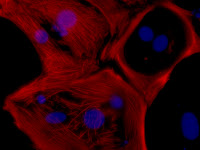 |
| Scripps Research scientists have created mature heart muscle cells directly from skin cells. |
Eventually, directly reprogramming one type of adult cell into another is going to be old news. For now, the entire field is new enough that each time scientists pluck one adult cell type and coerce it to become another, it’s exciting.
The most recent example comes from CIRM grantees at Scripps Research Institute, who converted mouse skin cells into beating heart cells in just 11 days. A press release quotes senior author Sheng Ding:
“It is like launching a rocket,” he said. “Until now, people thought you needed to first land the rocket on the moon and then from there you could go to other planets. But here we show that just after the launch you can redirect the rocket to another planet without having to first go to the moon. This is a totally new paradigm.”
Since 2006, scientists have been able to convert skin cells into embryonic-like iPS cells, which they could then mature into different cell types including heart. Directly converting skin to heart saves time, and could result in more effective therapies. According to the Scripps press release:
When, for example, scientists induce iPS cells to become heart cells, the resulting cells are a mix of heart cells and some lingering iPS cells. Scientists are concerned that giving these new heart cells (along with the remaining pluripotent cells) to patients might be dangerous. When pluripotent cells are injected in mice, they cause cancer-like growths.
Other CIRM grantees who have succeed in direct reprogramming include Marius Wernig at Stanford, who converted skin to nerve, and Deepak Srivastava, who converted heart fibroblasts into heart muscle cells.
Nature Cell Biology, January 30, 2011
CIRM funding: Sheng Ding (RN1-00536-1)
– A.A.



